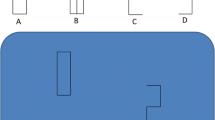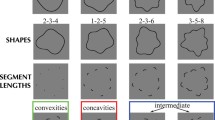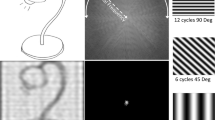Abstract
Two sources of visual information that likely could be employed by the perceptual system in locating the centers of bounded shapes—boundary configuration and luminance distribution—have been perfectly confounded in every study thus far aimed at investigating perceived centters. Observers, using either a revolving or stationary x-y plotter, made judgments on the location of centers within either revolving or stationary shapes of both uniform and varied luminance distributions. Results indicate that the location of perceived centers depended predominantly upon boundary contour and was affected by the distribution of luminance within these edges to a much lesser degree.
Article PDF
Similar content being viewed by others
Avoid common mistakes on your manuscript.
References
Alt, F. L. Digital pattern recognition by moments. In G. L. Fischer, Jr., D. K. Pollack, B. Raddack, & M. E. Stevens (Eds.),Opticai character recognition. Washington, D.C.: Spartan Books, 1962.
Békésy, G. von.Sensory inhibition. Princeton, N.J.: Princeton University Press, 1967.
Borjesson, E., &Von Hofsten, C. A vector model for perceived object rotation and translation in space.Psychological Research, 1975,38, 209–230.
Bruell, J. H., &Albee, U. W. Notes toward a motor theory of visual egocentric localization.Psychological Review, 1955, 62, 391–400.
Coren, S. The interaction between eye movements and visual perception. In D. F. Fisher, R. A. Monty, & J. W. Senders (Eds.),Eye movements: Cognition and visual perception. Hillsdale, N.J.: Erlbaum, 1981.
Cutting, J. E., &Proffitt, D. R. Gait perception as an example of how we may perceive events. In R. D. Walk & H. L. Pick (Eds.),Intersensory perception and sensory integration. New York: Plenum, 1981.
Cutting, J. E., &Proffitt, D. R. The minimum principle and the perception of absolute, common, and relative motions.Cognitive Psychololy, 1982,14, 211–246.
Duncker, K. [Induced motion.] In W. D. Ellis (Ed. and trans.),A source book of Gestalt psychology. London: Routledge & Kegan Paul, 1938. (Originally published, 1929.)
Gibson, J. J.The ecological approach to visual perception. Boston: Houghton Mifflin, 1979.
Haith, M. M.Rules that babies look by. Hillsdale, N.J.: Erlbaum, 1980.
Hebb, D. O.Organization of behavior. New York: Wiley, 1949.
Hu, M.-K. A mathematical model for visual perception. In E. E. Bernard & M. R. Kare (Eds.),Biological prototypes and synthetic systems. New York: Plenum Press, 1962.
Hubel, D. H., &Wiesel, T. N. Receptive fields, binocular interaction and functional architecture in the cat’s visual cortex.Journal of Physiology, 1962,160, 106–154.
Hubel, D. H., &Wiesel, T. N. Receptive fields and functional architecture of monkey striate cortex.Journal of Physiology, 1968,195, 215–243.
Johansson, G.Configuration in event perception. Uppsala: Almqvist & Wiskell, 1950.
Johansson, G. Visual perception of biological motion and a model for its analysis.Perception & Psychophysics, 1973,14, 201–211.
Johansson, G. Projective transformations as determining visual space perception. In R. B. MacLeod & H. L. Pick (Eds.),Perception: Essays in honor of James J. Gibson. Ithaca, N.Y: Cornell University Press, 1974.
Kaufman, L., &Richards, W. Spontaneous fixation tendencies for visual forms.Perception & Psychophysics, 1969,5, 85–88.
Kessen, W., Salapatek, P., &Haith, M. M. The visual response of the newborn to linear contour.Journal of Experimental Child Psychology, 1972,13, 9–20.
Lettvin, J. Y., Maturana, H. R., Mcculloch, W. S., &Pitts, W. H. What the frog’s eye tells the frog’s brain.Proceedings of the IRE, 1959,47, 1940–1951.
Pitts, W., &Mcculloch, W. S. How we know universals: The perception of auditory and visual forms.Bulletin of Mathematical Biophysics, 1947,7, 89–93.
Proffitt, D. R., &Cutting, J. E. Perceiving the centroid of configurations on a rolling wheel.Perception & Psychophysics, 1979,25, 389–398.
Proffitt, D. R., &Cutting, J. E. An invariant for wheelgenerated motions and the logic of its determination.Perception, 1980,9, 435–449. (a)
Proffitt, D. R., &Cutting, J. E. Perceiving the centroid of curvilinearly bounded roiling shapes.Perception & Psychophysics, 1980,28, 484–487. (b)
Proffitt, D. R., Cutting, J. E., &Stier, D. M. Perception of wheel-generated motions.Journal of Experimental Psychology: Human Perception and Performance, 1979,5, 289–302.
Proffitt, D. R., &O’brien, R. G. Standardizing distances of observations within shapes.Perception & Psychophysics, 1982,32, 302–305.
Proffitt, D. R., &Simmons, R. W. A revolving X-Y plotter for studying the perception of rotational motions.Behavior Research Methods &Instrumentation, 1980,12, 601–604.
Ratliff, F.Mach bands: Quantitative studies on neural networks in the retina. San Francisco: Holden-Day, 1965.
Richards, W., &Kaufman, L. “Center-of-gravity” tendencies for fixations and flow patterns.Perception & Psychophysics, 1969,5, 81–84.
Rubin, E. Visuell wahrgenommene wirkliche Bewegungen.Zeitschrift für Psychologie, 1927,103, 384–392.
Virsu, V. Tendencies to eye movement, and misperception of curvature, direction, and length.Perception & Psychophysics, 1971,9, 65–72.
Wallach, H. Visual perception of motion. In G. Keyes (Ed.),The nature of the art of motion. New York: Braziller, 1965. (Also in H. Wallach.On perception. New York: Quadrangle, 1976).
Zusne, L.Visualperception of form. New York: Academic Press, 1970.
Zusne, L., &Michels, K. M. Nonrepresentational shapes and eye movements.Perceptual and Motor Skills, 1964,18, 11–20.
Author information
Authors and Affiliations
Additional information
This research was supported by NIH Grant MH 35530.
Rights and permissions
About this article
Cite this article
Proffitt, D.R., Thomas, M.A. & O’brien, R.G. The roles of contour and luminance distribution in determining perceived centers within shapes. Perception & Psychophysics 33, 63–71 (1983). https://doi.org/10.3758/BF03205866
Received:
Accepted:
Issue Date:
DOI: https://doi.org/10.3758/BF03205866




